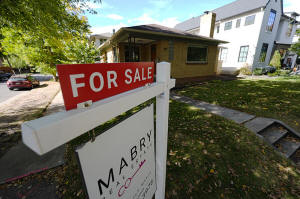Trump's economic agenda for his second term is clouding the outlook for
mortgage rates
 Send a link to a friend
Send a link to a friend
 [November 13, 2024] By
ALEX VEIGA [November 13, 2024] By
ALEX VEIGA
LOS ANGELES (AP) — Donald Trump’s election win is clouding the outlook
for mortgage rates even before he gets back to the White House.
The president-elect campaigned on a promise to make homeownership more
affordable by lowering mortgage rates through policies aimed at knocking
out inflation. But his proposed economic agenda could potentially set
the stage for mortgage rates to move higher, some economists and
analysts say.
Mortgage rates are influenced by several factors, including moves in the
yield for U.S. 10-year Treasury bonds, which lenders use as a guide to
price home loans. Treasury yields rose in recent weeks even after the
Federal Reserve cut its benchmark interest rate, which influences rates
on all types of loans including mortgages. Investors appeared to
question how far the Fed should cut rates given the strength of the
economy.
Then yields surged further immediately after Trump’s victory, sending
the average rate on a 30-year mortgage up to 6.79%, according to
mortgage buyer Freddie Mac.
“Given what we’re seeing in bond markets, investors are expecting higher
rates under a Trump administration and are starting to position in that
direction already,” said Danielle Hale, chief economist at Realtor.com.
“So, if overall rates are higher, that would tend to also mean that
mortgage rates would move higher, too.”

Trump says he wants to impose tariffs on foreign goods, lower tax rates
and lighten regulations, policies that could rev up the economy, but
also fuel inflation and increase U.S. government debt — and, say some
economists, lead to higher interest rates and in turn higher mortgage
rates.
“Trump’s fiscal policies can be expected to lead to rising and more
unpredictable mortgage rates through the end of this year and into
2025,” said Lisa Sturtevant, chief economist with Bright MLS, who no
longer forecasts the average rate on a 30-year home loan to dip below 6%
next year.
Homebuilding sector analysts at Raymond James and Associates see
mortgage rates remaining “higher for longer,” given the outcome of the
election. They also said in a research note last week that first-time
homebuyers “are likely to face even greater affordability challenges
this spring,” typically the peak sales season of the year for
homebuilders.
Higher mortgage rates can add hundreds of dollars a month in costs for
borrowers, reducing their purchasing power at a time when home prices
remain near record highs despite a housing market sales slump dating
back to 2022.
Elevated mortgage rates and high prices have kept homeownership out of
reach for many first-time buyers. They accounted for just 24% of all
homes purchased between July 2023 and last June, a historic low going
back to 1981, according to data from the National Association of
Realtors. Prior to 2008, the share of first-time buyers had historically
been 40%.
As more Americans are priced out of homeownership or have to delay
buying a home, they're missing out on potential gains from home equity
growth, which have historically been a strong driver of personal wealth.
What’s more, higher mortgage rates can discourage current homeowners
from selling. While the average rate on a 30-year home loan has come
down from a 23-year high of nearly 8% last year, it remains too high for
many potential sellers. More than four in five homeowners with a
mortgage have an existing rate below 6%, according to Realtor.com.

[to top of second column] |

A sale sign stands outside a home on the market Thursday, Oct. 17,
2024, in the east Washington Park neighborhood of Denver. (AP
Photo/David Zalubowski, File)
 The surge in bond yields last week
likely reflects expectations among investors that Trump’s proposed
economic policies would widen the federal deficit and crank up
inflation.
The nonpartisan Committee for a Responsible Federal Budget forecasts
that Trump’s proposals would increase the federal budget deficit by
$7.75 trillion over the next decade.
To pay interest on that debt, the government will likely have to
issue more bonds, like 10-year Treasurys. That could lead investors
to demand higher yields, or the return they receive for investing in
the bonds. As those yields go up, that would push mortgage rates
higher.
If inflation were to heat up again, the Fed may have to pause the
rate cuts it began in September. Inflation has fallen on an annual
basis from a 9.1% peak in 2022 to a 3 1/2-year low of 2.4% as the
Fed raised rates to the highest level in decades.
While the central bank doesn’t set mortgage rates, its actions and
the trajectory of inflation influence the moves in the 10-year
Treasury yield. The central bank’s policy pivot is expected to
eventually clear a path for mortgage rates to generally go lower.
But that could change if the next administration’s policies send
inflation into overdrive again.
“The general expectation is still there are a lot of reasons to
expect that mortgage rates could come down, but policy is a pretty
big wildcard,” said Hale of Realtor.com.
Forecasting the trajectory of mortgage rates is difficult, given
that rates are influenced by many factors, from government spending
and the economy, to geopolitical tensions and stock and bond market
gyrations.
Leading up to the election, housing economists had generally
expected the average rate on a 30-year mortgage to drop through the
end of this year to around 6% and then ease further next year. Now,
economists at the Mortgage Bankers Association and Realtor.com
expect the average rate will hover around 6% next year, while those
at First American says it's possible that rates decline to around 6%
but not a given.
Redfin's head of economic research, Chen Zhao, meanwhile, has said
"it's pretty hard to imagine mortgage rates below 6% next year
unless we get a recession.”

The National Association of Realtors estimates that the average rate
on a 30-year mortgage will bounce between 5.5% and 6.5% during
Trump’s second term.
“If the Trump administration can lay out a credible plan to reduce
the budget deficit, then mortgage rates can move downward,” said
Lawrence Yun, NAR's chief economist.
Regardless, don’t expect mortgage rates to return to the lows they
hit during Trump’s first term, which started in late January 2017
and ended four years later.
Back then, the average rate on a 30-year mortgage ranged from a
record-low of 2.65% to 4.94%. Mortgage rates fell sharply in the
last year of Trump’s first term as the economic fallout from the
COVID-19 pandemic led investors to seek the safety of U.S.
government bonds, which sent their yields sharply lower.
All contents © copyright 2024 Associated Press. All rights reserved |